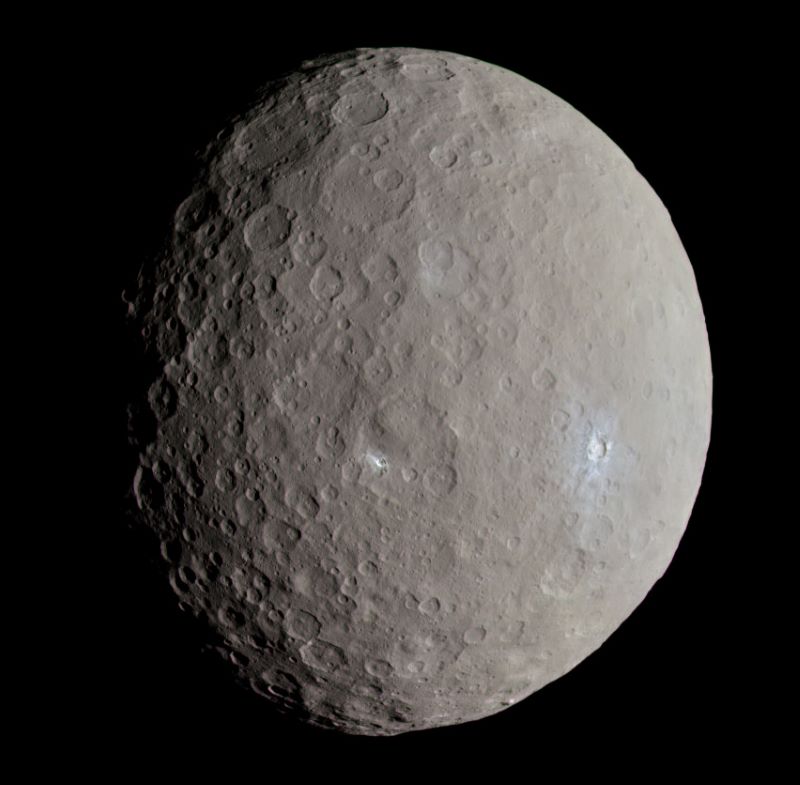
Was Ceres a muddy ocean world?
Ceres is the largest object in the main asteroid belt. Scientists now consider it a dwarf planet instead of an asteroid because it has enough mass to be round. On September 25, 2024, scientists from Purdue University and NASA said Ceres’ crust is probably made from 90% ice today. Using data from NASA’s Dawn mission, they found it was likely once a muddy ocean world.
Dawn orbited Ceres in 2016, coming within 233 miles (375 km) of its surface. Ceres looks a bit like Mercury or the far side of our moon, pockmarked with impact craters. Astronomers had long thought that because the dwarf planet is covered in craters, it must not be very icy.
But between the Dawn observations and computer simulations, the team of scientists was able to show that Ceres can maintain its cratered topography while also having an ice-rich crust. The journal Nature Astronomy published the team’s peer-reviewed findings on September 18, 2024.
Dirty ice, muddy ocean
The team made their conclusions after running simulations of how Ceres’ crust evolved over billions of years. Mike Sori of Purdue University, one of the authors on the new paper, said:
We think that there’s lots of water-ice near Ceres’ surface, and that it gets gradually less icy as you go deeper and deeper. People used to think that if Ceres was very icy, the craters would deform quickly over time, like glaciers flowing on Earth, or like gooey flowing honey. However, we’ve shown through our simulations that ice can be much stronger in conditions on Ceres than previously predicted if you mix in just a little bit of solid rock.
So it’s not just ice, but dirty ice. And in the past it would have been warmer, forming an ocean, the scientists said. Sori continued:
Our interpretation of all this is that Ceres used to be an ‘ocean world’ like Europa (one of Jupiter’s moons), but with a dirty, muddy ocean. As that muddy ocean froze over time, it created an icy crust with a little bit of rocky material trapped in it.
How they did it
Ian Pamerleau, another author also from Purdue University, explained how they came to their conclusions:
We used multiple observations made with Dawn data as motivation for finding an ice-rich crust that resisted crater relaxation on Ceres. Different surface features (e.g., pits, domes and landslides, etc.) suggest the near subsurface of Ceres contains a lot of ice. Spectrographic data also shows that there should be ice beneath the regolith [crust] on the dwarf planet. And gravity data yields a density value very near that of ice, specifically impure ice. We also took a topographic profile of an actual complex crater on Ceres and used it to construct the geometry for some of our simulations.
Even solids will flow over long timescales, and ice flows more readily than rock. Craters have deep bowls which produce high stresses that then relax to a lower stress state, resulting in a shallower bowl via solid state flow. So the conclusion after NASA’s Dawn mission was that due to the lack of relaxed, shallow craters, the crust could not be that icy.
Our computer simulations account for a new way that ice can flow with only a little bit of non-ice impurities mixed in, which would allow for a very ice-rich crust to barely flow even over billions of years. Therefore, we could get an ice-rich Ceres that still matches the observed lack of crater relaxation. We tested different crustal structures in these simulations and found that a gradational crust with a high ice content near the surface that grades down to lower ice with depth was the best way to limit relaxation of Cerean craters.
How Ceres fits in our solar system
Sori summed up:
To me the exciting part of all this, if we’re right, is that we have a frozen ocean world pretty close to Earth. Ceres may be a valuable point of comparison for the ocean-hosting icy moons of the outer solar system, like Jupiter’s moon Europa and Saturn’s moon Enceladus. Ceres, we think, is therefore the most accessible icy world in the universe. That makes it a great target for future spacecraft missions.
Some of the bright features we see at Ceres’ surface are the remnants of Ceres’ muddy ocean, now mostly or entirely frozen, erupted onto the surface. So we have a place to collect samples from the ocean of an ancient ocean world that is not too difficult to send a spacecraft to.

Bottom line: Ceres – a dwarf planet in the main asteroid belt – may once have been a muddy ocean world. That makes it a great target for future spacecraft missions.
Source: An ancient and impure frozen ocean on Ceres implied by its ice-rich crust











